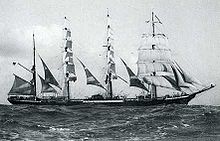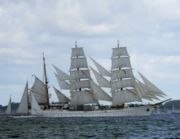- Gorch Fock (1933)
-
 Flag of Stralsund and painted over "товарищ"
Flag of Stralsund and painted over "товарищ"
The Gorch Fock I (ex Tovarishch, ex Gorch Fock) is a German three-mast barque, the first of a series built as school ships for the German Reichsmarine in 1933. She was taken as war reparations by the USSR after World War II and renamed Tovarishch. After a short period under the Ukrainian flag in the 1990s and a prolonged stay in British ports due to lack of funds for necessary repairs, the ship was acquired by sponsors and sailed to her original home port of Stralsund, where her original name of Gorch Fock was restored on November 29, 2003. She is a museum ship, and extensive repairs were carried out in 2008
The Federal German government built a replacement training ship, the Gorch Fock (1958), which is still in service.
Contents
History and details
 "Gorch Fock" in Stralsund
"Gorch Fock" in Stralsund
The German school ship Segelschulschiff Niobe, a four-masted barque, capsized on July 26, 1932 in the Baltic Sea near Fehmarn due to a sudden squall, killing 69. The loss prompted the German Navy to order a new training vessel built. The contract went to the shipyard of Blohm & Voss in Hamburg, where construction began on December 2, 1932. She was completed in only 100 days. On May 3, 1933 the ship was launched and baptized Gorch Fock in honor of German writer Johann Kinau who wrote under the pseudonym "Gorch Fock". Kinau had died in the 1916 Battle of Jutland aboard the cruiser SMS Wiesbaden.
Commissioned by the German Navy on June 26, 1933, the "Gorch Fock" is a three masted barque. She has square sails on the fore and main masts, and is gaff rigged on the mizzen. The hull steel and has a sparred length of 82.1 m (269 ft), a width of 12 m (39 ft) and a draught of 5.2 m (17 ft). She has a displacement at full load of 1510 tons. Her main mast stands 41.30 m (135 ft) high above deck and she carries 23 sails totalling 1,753 m2 (18,869 sq ft). She is equipped with an auxiliary engine of 410 kW (550 hp).
The training ship was designed to be robust and safe against capsizing. More than 300 tons of steel ballast in the keel give her a righting moment large enough to bring her back in the upright position even when she heels over to nearly a 90°.
The Gorch Fock served as a training vessel for the German Reichsmarine prior to World War II. During the war, she was a stationary office ship in Stralsund, until she was officially reactivated on April 19, 1944. On 1 May 1945, the crew scuttled her in shallow waters off Rügen in an attempt to avoid her capture by the Soviets, who already had fired at her for 45 minutes with tanks.
The Soviets ordered Stralsund-based company "B. Staude Schiffsbergung" to raise and salvage her, which after some difficulties was done in 1947 at a cost of 800,000 Reichsmark. She was under restoration between 1948 and 1950. She was then named Tovarishch ("Comrade" in Russian) in 1951 and put into service as a training vessel. Her new home port was Odessa. She participated in many Tall Ships' Races and cruised far and wide on the seven seas. She made a voyage around the world in 1957 and won the Operation Sail race twice, in 1974 and 1976.
After the dissolution of the Soviet Union in 1991, the Tovarishch sailed under the Ukrainian flag (home port Kherson) until 1993, when she was needed repairs and deactivated for lack of funds. In 1995, she sailed from Kherson to Newcastle-upon-Tyne, where private sponsors wanted to have her repaired. This failed because of the high costs, and in 1999, the ship was transported to Wilhelmshaven, where she stayed in dock for four years until finally transferred to Stralsund in 2003. On November 29, 2003 the ship was re-christened Gorch Fock.
As of 2011 the ship is in poor but stable condition. There is about six million dollars worth of restoration work required to bring this ship back to sailing condition. The museum had a dismal tourist season resulting in a fifty thousand dollar loss in revenue from previous years. This has forced a layoff of five workers. for further information and to help save this ship visit the webstite http://www.gorchfock1.de/front_content.php?idcat=29
Sister ships
The design of the Gorch Fock proved highly successful. She was the first of a series of five ships built by Blohm & Voss, and a number of South American school ships are also based on the same design. Of the three original sister ships, only the Mircea is an exact replica of the Gorch Fock. The Horst Wessel and the Albert Leo Schlageter are 7 meters longer, and all three have slightly more powerful auxiliary engines.
USCGC Eagle (ex Horst Wessel)
The Horst Wessel was launched in 1936—the growing Reichsmarine needed more school ships. Her home port was Kiel. At the end of World War II, she was assigned to the U.S. After some repairs in Wilhelmshaven and Bremerhaven, she was sailed by her German crew including the Captain together with American sailors to her new home port of New London, Connecticut. Since then, she sails under the name Eagle for the United States Coast Guard.
Sagres III (ex Albert Leo Schlageter)
The Albert Leo Schlageter was launched on October 30, 1937. She was confiscated by the United States after World War II, and then sold to Brazil, where she sailed as a school ship under the name Guanabara. In 1961, the Portuguese Navy bought her to replace the old school ship Sagres II (which was later transferred to Hamburg, where she is a museum ship under her original name Rickmer Rickmers). The Portuguese named her accordingly Sagres III. She still sails as of 2011, having completed a circumnavigation on the 24th of December 2010.
Mircea
The Mircea was built by Blohm & Voss for the Romanian Navy. She was launched in 1938 and has always sailed under the Romanian flag (except for a short period after WWII, when she was confiscated by the Soviet Union). She is the only one of the sister ships that is truly identical to the Gorch Fock. She was overhauled at the Blohm & Voss shipyards in Hamburg in 1966, and she still sails today[update].
Herbert Norkus
Named after the Hitler Youth martyr Herbert Norkus, another ship of the Gorch Fock design—with the same dimensions as the Horst Wessel—was begun at the Blohm & Voss shipyard. However,the unfinished ship had to be launched prematurely on November 7, 1939 because the slipway had to be cleared to build submarines. The hull stayed in the harbor of Hamburg throughout World War II. It was damaged in a bomb raid in 1945, and instead of being sold to Brazil as had been considered, ended up being filled with gas grenades and sunk in the Skagerrak in 1947.
The yards, which had been prepared, but not yet mounted, and the tackle, which had not yet been rigged, were later used for the Gorch Fock built in 1958.
Gorch Fock
 The barque Pamir.
The barque Pamir.
As Germany had lost all of its training vessels as war reparations after World War II, the West German Bundesmarine decided in 1957 to have a new training ship built following the plans for the Gorch Fock. The new ship was a modernized rebuild of the Segelschulschiff Horst Wessel. Coincidentally, her design had been influenced by another shipwreck: whereas the 1933 Gorch Fock was built in response to the Niobe disaster, the plans of the SSS Gorch Fock were altered somewhat after the sinking of the Pamir in 1957.
The modern-day SSS Gorch Fock was launched on August 23, 1958 and commissioned on December 17 of that year.
Latin American ships
A number of similar ships have been built by the Astilleros Celaya S.A. shipyard in Bilbao for Latin American Navies, possibly following the Blohm & Voss design. The hulls and rigging of these ships are very similar, the main differences are in the superstructure and they also have larger tanks for both diesel and water, and they are also longer. These ships are the Gloria (1967, Colombia), the Guayas (1976, Ecuador), the Simón Bolívar (1979, Venezuela), and the Cuauhtémoc (1982, Mexico).
External links
- The correct homepage of "Gorch Fock 1"
- ESYS page on the whole family of ships (in German).
- ESYS page with links to the five original ships (in German).
- JanMaat—another German site on the Gorch Fock (ex Tovarishch).
Coordinates: 54°19′00″N 13°05′54″E / 54.3166667°N 13.09833°E
Categories:- Barques
- Museum ships in Germany
- Individual sailing vessels
- Sailing ships of Germany
- Ships built in Hamburg
- Ships of Russia
- Ships of Ukraine
- Three-masted ships
- Tall ships of Germany
- 1933 ships
Wikimedia Foundation. 2010.






